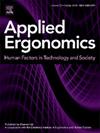被动背支撑外骨骼在血管手术中的可用性和姿势益处:初步研究
IF 3.4
2区 工程技术
Q2 ENGINEERING, INDUSTRIAL
引用次数: 0
摘要
笨拙的躯干姿势,如外科医生在手术室中要求的静态弯曲和扭曲,是外科医生中工作相关肌肉骨骼疾病高发的主要因素。目前提出的一种干预措施是术中佩戴被动式外骨骼,以减少术中笨拙姿势带来的压力。在这项研究中,我们测量了三种类型血管手术中使用两种商用外骨骼的术中姿势、主观不适、工作量以及可用性,并比较了基线(不使用外骨骼)和两种不同躯干外骨骼(Laevo和HeroWear)的结果。线性混合模型发现,虽然外骨骼对手术流程没有显著干扰,但外骨骼的使用对血管外科医生的术中躯干姿势(28°vs. 27°vs. 34°,p > 05)、主观不适变化(2.0 vs. 1.25 vs. 1.92, p = 0.807,腰背部)(3.00 vs. 1.58 vs. 2.58, p = 0.454,上背部)和(3.00 vs. 2.75 vs. 1.92, 0.153)或工作量没有显著影响。建议进一步研究外骨骼在血管外科手术中减少不适和人体工程学危险因素的有效性。本文章由计算机程序翻译,如有差异,请以英文原文为准。
Usability and postural benefits of passive back-support exoskeletons in vascular surgery: A preliminary study
The awkward trunk postures such as static flexion and twisting required of surgeons in the operating room are a major contributing factor to the high prevalence of work-related musculoskeletal disorders amongst surgeons. One intervention that is currently proposed to reduce the strain associated with awkward intraoperative postures are passive exoskeletons worn intraoperatively. In this study, we measured the intraoperative postures, subjective discomfort, and workload as well as the usability associated with two commercially available exoskeletons during three types of vascular surgery and compared the results between a baseline (not using exoskeleton) and two different trunk exoskeletons (Laevo and HeroWear). A linear mixed model found that while the exoskeletons did not significantly interfere with surgical workflow, use of the exoskeletons did not significantly affect intraoperative trunk postures (28° vs. 27° vs. 34°, p > .05), subjective discomfort change (2.0 vs. 1.25 vs. 1.92, p = .807 in the low back) (3.00 vs. 1.58 vs. 2.58, p = .454 in the upper back), and (3.00 vs. 2.75 vs. 1.92, 0.153 overall fatigue change), or workload in vascular surgeons. Further research on the effectiveness of exoskeletons in vascular surgeons in reducing discomfort and ergonomic risk factors is recommended.
求助全文
通过发布文献求助,成功后即可免费获取论文全文。
去求助
来源期刊

Applied Ergonomics
工程技术-工程:工业
CiteScore
7.50
自引率
9.40%
发文量
248
审稿时长
53 days
期刊介绍:
Applied Ergonomics is aimed at ergonomists and all those interested in applying ergonomics/human factors in the design, planning and management of technical and social systems at work or leisure. Readership is truly international with subscribers in over 50 countries. Professionals for whom Applied Ergonomics is of interest include: ergonomists, designers, industrial engineers, health and safety specialists, systems engineers, design engineers, organizational psychologists, occupational health specialists and human-computer interaction specialists.
 求助内容:
求助内容: 应助结果提醒方式:
应助结果提醒方式:


